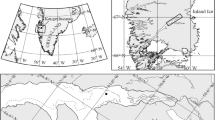Abstract
A study of sea ice biota was carried out in the Gulf of Bothnia (northern Baltic Sea) during the winter of 1989–1990. Samples (ice cores) were taken at a coastal station at regular time intervals during the ice season. Chlorophyll a concentration, algal species distribution, bacterial numbers, and primary and bacterial production were measured. Colonization of the ice began in January when daylight was low. As the available light increased, the algae started to grow exponentially. The vertical chlorophyll a distribution changed and algal species composition and biomass changed during the season. During the initial and middle phase of colonization, ice-specific diatoms, Nitzschia frigida and Navicula pelagica, dominated the algal biomass. Nutrients (PO4 3− and NO3j) were found to be depleted during the time of algal exponential growth. The maximum algal biomass exceeded 800 μg C 1−1. The primary production supplied food for heterotrophic organisms. The presence of heterotrophic organisms of different trophic levels (bacteria, flagellates, ciliates and rotifers) indicated an active microbial food web.
Similar content being viewed by others
References
Alexander V, Chapman T (1981) The role of epontic algal communities in Bering Sea ice. In: Hood DW and Calder JA (eds) The eastern Bering Sea shelf: oceanography and resources, Univ of Washington press, Seattle. 2. pp 773–780
Andersson A, Haecky P, Hagström Å Effect of light and temperature on the growth of micro-, nano-and picoplankton: impact on algal succession. Mar Biol (in press)
Anonymous (1988) Guidelines for the Baltic monitoring program for the third stage. Part D. Biological determinants. HELCOM, Baltic Sea Environment Proceedings 27D
Arvola L (1981) Spectrophotometric determination of chlorophyll a and phaeopigments in ethanol extractions. Ann Bot Fennici 18:221–227
Caron DA (1983) Technique for enumeration of heterotrophic and phototrophic nanoplankton, using epifluorescense microscopy and comparisons with other procedures. Appl Environ Microbiol 46:491–498
Edler L (1979) Recommendations on methods for marine biological studies in the Baltic Sea, phytoplankton and chlorophyll. Baltic Mar Biol Publ 5:1–38
Fuhrman JA, Azam F (1982) Thymidine incorporation as a measure of heterotrophic bacterioplankton production in marine surface waters: evaluation and field results. Mar Biol 66:109–120
Grasshof K, Erhardt M, Kremling K (1983) Methods of seawater analysis. Verlag Chemie, Weinheim
Grøntved J (1950) Nitzschia frigida Grun., an Arctic-Baltic diatom found in Danish water. K Dansk Vidensk Selskb Medd 18:1–19
Hällfors G, Niemi Å (1974) A Chrysocromulina (Haptophyceae) bloom under the ice in the Tvärminne archipelago, southern coast of Finland. Memo Soc Fauna Flora Fenn 50:89–104
Horner R (1985a) Ecology of sea ice microalgae. In: Horner R (ed) Sea ice biota. CRC Press, Boca Raton pp 83–104
Horner R (1985b) History of ice algal investigations. In: Horner R (eds) Sea ice biota. CRC Press, Boca Raton, pp 2–19
Horner R, Alexander V (1972) Algal populations in Arctic sea ice: An investigation of heterotrophy. Limnol Oceanogr 17:454–458
Horner R, Schrader GC (1982) Relative contribution of ice algae phytoplankton and benthic microalgae to primary production in nearsshore regions of the Beaufort Sea. Arctic 35:485
Huttunen M, Niemi Å (1986) Sea-ice algae in the northern Baltic Sea. Memoranda Soc Fauna Flora Fennica 62:58–62
Johansson S (1983) Annual dynamics and production of rotifers in an eutrophication gradient in the Baltic Sea. Hydrobiologia 104:335–340
Kankaala P, Johansson S (1986) The influence of individual variation on length —biomass regressions in three crustacean species. J Plankton Res 8:1027–1038
Kuosa H, Norrman B, Kivi K, Brandini F (1992) Seeding impacts of Weddell Sea (Antarctica) sea ice biota as studied in aquarium experiments. Polar Biol 12:333–339
Kuparinen J, Leonardsson K, Mattita J, Wikner J (1994) Ecology of the Gulf of Bothnia: Food web structure, material flow and trends, Skârgård 1:37–66 (In Swedish/Finnish)
Legendre L, Martineau MJ, Therriault JC, Deniers S (1992) Chlorophyll a biomass and growth of sea-ice microalgae along a salinity graident (southeastern Hudson Bay, Canadian Arctic). Polar Biol 12:445–453
Muller-Haeckel A (1982) Nanoplankton under ice and snow cover in a coastal area of the Bothnian Sea. In: Müller K (ed) Coastal Research in the Gulf of Bothnia. Junk, The Hague, pp 225–231
Müller-Haeckel A (1985) Shade-adapted algae beneath ice and snow in the northern Bothnian Sea. Int Rev Gesamten Hydrobiol 325:325–334
Perry MJ, Talbot MC, Albete RS (1981) Photoadaption in marine phytoplankton: response of the photosynthetic unit. Mar Biol 62:91–101
Peterson BJ, Fry B (1987) Stable isotopes in ecosystem studies. Ann Rev Ecol Sys 18:293–320
Porter KG, Feig YS (1980) The use of DAPI for identifying and counting aquatic microflora. Limnol Oceanogr 31:1010–1021
Runge JA, Therriault JC, Legendre L, Ingram RG, Deniers S (1991) Coupling between ice microalgal productivity and the pelagic, metazoan, food web in southeastern Hudson Bay: a synthesis of results. Polar Res 10:325–338
Steeman Nielsen E (1952) The use of radioactive (14C) for measuring organic production in the sea. J Cons Int Explor Mer 18: 117–140
Syvertsen EE, Hasle GR (1987) Melosira arctica in the Baltic Sea and in the Oslofjord. Proceedings of Nordica Diatomist Meeting 12:79–84
Waterbury JB, Watson SW, Valois FW, Franks DG (1986) Biological and ecological characterization of the marine unicellular cyanobacterium Synechococcus. Can Bull Fish Aquat Sci 214:71–20
Welch HE, Bergmann MA (1989) Seasonal development of ice algae and its prediction from environmental factors near Resolute, N.W.T., Canada. Can J Fish Aquat Sci 46:1793–1804
Wikner J, Hagström Å, Norrman B, Andersson A, Lundberg E (1992) Intensive monitoring of a coastal area in the northern Bothnian Sea; 1990. UMF, PMK rapport (in Swedish)
Author information
Authors and Affiliations
Rights and permissions
About this article
Cite this article
Norrman, B., Andersson, A. Development of ice biota in a temperate sea area (Gulf of Bothnia). Polar Biol 14, 531–537 (1994). https://doi.org/10.1007/BF00238222
Received:
Accepted:
Issue Date:
DOI: https://doi.org/10.1007/BF00238222




